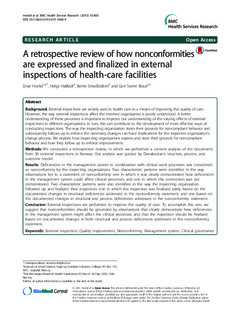| dc.contributor.author | Hovlid, Einar | |
| dc.contributor.author | Høifødt, Helge | |
| dc.contributor.author | Smedbråten, Bente | |
| dc.contributor.author | Braut, Geir Sverre | |
| dc.date.accessioned | 2016-02-01T13:38:31Z | |
| dc.date.available | 2016-02-01T13:38:31Z | |
| dc.date.issued | 2015 | |
| dc.identifier.citation | Hovlid, E., Høifødt, H., Smedbråten, B., & Braut, G. (2015). A retrospective review of how nonconformities are expressed and finalized in external inspections of health-care facilities. BMC Health Services Research, 15(1), 405. | nb_NO |
| dc.identifier.issn | 1472-6963 | |
| dc.identifier.uri | http://hdl.handle.net/11250/2375541 | |
| dc.description.abstract | Background: External inspections are widely used in health care as a means of improving the quality of care. However, the way external inspections affect the involved organization is poorly understood. A better understanding of these processes is important to improve our understanding of the varying effects of external inspections in different organizations. In turn, this can contribute to the development of more effective ways of conducting inspections. The way the inspecting organization states their grounds for noncompliant behavior and subsequently follows up to enforce the necessary changes can have implications for the inspected organization’s change process. We explore how inspecting organizations express and state their grounds for noncompliant behavior and how they follow up to enforce improvements.
Methods: We conducted a retrospective review, in which we performed a content analysis of the documents from 36 external inspections in Norway. Our analysis was guided by Donabedian’s structure, process, and outcome model.
Results: Deficiencies in the management system in combination with clinical work processes was considered as nonconformity by the inspecting organizations. Two characteristic patterns were identified in the way observations led to a statement of nonconformity: one in which it was clearly demonstrated how deficiencies in the management system could affect clinical processes, and one in which this connection was not demonstrated. Two characteristic patterns were also identified in the way the inspecting organization followed up and finalized their inspection: one in which the inspection was finalized solely based on the documented changes in structural deficiencies addressed in the nonconformity statement, and one based on the documented changes in structural and process deficiencies addressed in the nonconformity statement.
Conclusion: External inspections are performed to improve the quality of care. To accomplish this aim, we suggest that nonconformities should be grounded by observations that clearly demonstrate how deficiencies in the management system might affect the clinical processes, and that the inspection should be finalized based on documented changes in both structural and process deficiencies addressed in the nonconformity statement. | nb_NO |
| dc.language.iso | eng | nb_NO |
| dc.publisher | BioMed Central | nb_NO |
| dc.rights | Navngivelse 3.0 Norge | * |
| dc.rights.uri | http://creativecommons.org/licenses/by/3.0/no/ | * |
| dc.subject | external inspection | nb_NO |
| dc.subject | quality improvement | nb_NO |
| dc.subject | nonconformity | nb_NO |
| dc.subject | management system | nb_NO |
| dc.subject | clinical governance | nb_NO |
| dc.title | A retrospective review of how nonconformities are expressed and finalized in external inspections of health-care facilities | nb_NO |
| dc.type | Journal article | nb_NO |
| dc.type | Peer reviewed | nb_NO |
| dc.source.volume | 15 | nb_NO |
| dc.source.journal | BMC Health Services Research | nb_NO |
| dc.identifier.doi | 10.1186/s12913-015-1068-9 | |
| dc.identifier.cristin | 1275219 | |

